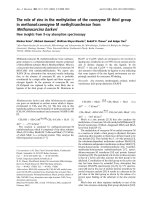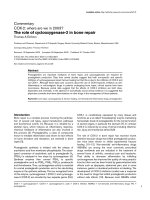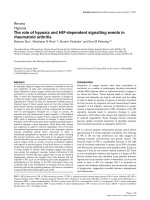Báo cáo y học: "Current role of surgery in small cell lung carcinoma" pot
Bạn đang xem bản rút gọn của tài liệu. Xem và tải ngay bản đầy đủ của tài liệu tại đây (203.72 KB, 6 trang )
BioMed Central
Page 1 of 6
(page number not for citation purposes)
Journal of Cardiothoracic Surgery
Open Access
Review
Current role of surgery in small cell lung carcinoma
Efstratios N Koletsis*
1
, Christos Prokakis
1
, Menelaos Karanikolas
2
,
Efstratios Apostolakis
1
and Dimitrios Dougenis
1
Address:
1
Department of Cardiothoracic Surgery, School of Medicine, University of Patras, Greece and
2
Department of Anaesthesiology and
Critical Care Medicine, School of Medicine, University of Patras, Greece
Email: Efstratios N Koletsis* - ; Christos Prokakis - ;
Menelaos Karanikolas - ; Efstratios Apostolakis - ;
Dimitrios Dougenis -
* Corresponding author
Abstract
Small cell lung carcinoma represents 15–20% of lung cancer. Is is characterized by rapid growth and
early disseminated disease with poor outcome. For many years surgery was considered a
contraindication in Small Cell Lung Cancer (SCLC) since radiotherapy and chemoradiotherapy
were found to be more efficient in the management of these patients. Never the less some
surgeons continue to be in favor of surgery as part of a combined modality treatment in patients
with SCLC. The revaluation of the role of surgery in this group of patients is based on clinical data
indicating a much better prognosis in selected patients with limited disease (T1-2, N0, M0), the high
rate of local recurrence after chemoradiotherapy with surgery considered eventually more efficient
in the local control of the disease and the fact that surgery is the most accurate tool to access the
response to chemotherapy, identify carcinoids misdiagnosed as SCLC and treat the Non Small Cell
Lung Cancer component of mixed tumors. Performing surgery for local disease SCLC requires a
complete preoperative assessment to exclude the presence of nodal involvement. In stage I surgery
must always be followed by adjuvant chemotherapy, while in stage II and III surgery must be planned
only in the context of clinical trials and after a pathologic response to induction chemoradiotherapy
has been confirmed. Prophylactic cranial irradiation should be used to reduce the incidence of brain
metastasis
Background
Small cell lung carcinoma represents 15–20% of all lung
cancer and it is basically characterized by rapid growth
and early metastatic dissemination. As a result, systemic
chemotherapy, with or without radiotherapy, has been
typically accepted as the cornerstone of therapy in SCLC
[1]. Initially surgery was the treatment of choice for all
types of lung cancer but it was abandoned for the subset
of SCLC almost 30 years ago after the results of the Medi-
cal Research Council (UK) randomized trial which com-
pared radiotherapy and surgery in patients with limited
disease [2]. Although the mean survival was less than a
year, a small but significant difference in the survival was
shown in the two groups of the study: 4 year survival of
3% in the surgery arm and 7% in the radiotherapy arm. A
5 year survival of 5% was noted only in the radiotherapy
arm. This report although severely criticized on a number
of points, rejected surgery and made radiation therapy the
standard form of treatment for many years there after. At
about the same period, the first demonstration of the ben-
Published: 9 July 2009
Journal of Cardiothoracic Surgery 2009, 4:30 doi:10.1186/1749-8090-4-30
Received: 26 January 2009
Accepted: 9 July 2009
This article is available from: />© 2009 Koletsis et al; licensee BioMed Central Ltd.
This is an Open Access article distributed under the terms of the Creative Commons Attribution License ( />),
which permits unrestricted use, distribution, and reproduction in any medium, provided the original work is properly cited.
Journal of Cardiothoracic Surgery 2009, 4:30 />Page 2 of 6
(page number not for citation purposes)
eficial effects of chemotherapy (CT) (cyclophosphamide
vs placebo) was reported by Green et al [3]. They reported
a mean survival of 12 weeks with CT compared to only 6
weeks without any treatment. Since that time a great
progress has been made in the management of SCLC, tak-
ing in account these very poor initial reports. Recently
patients with limited disease are treated with curative
intent with chemoradiotherapy with a median survival of
23 months and a 5 years survival rate of 12–17%. How-
ever, only 30% of all patients with SCLC present limited
disease (LD-SCLC). In extensive disease the 5 year survival
rate is only 2% [1].
Materials and methods
The question raised and on which was based this review is
whether the adjunction of surgery in the small cell lung
carcinoma's management may influence the outcome of
specific subset of patients. We proceeded to a review of the
Medline PUBMED (January 1980 to Week 1, January
2009) and EMBASE (January 1980 to Week 1, January
2009) literature focusing on retrospective studies where
the impact of surgery on survival was evaluated as a stage
dependent event. Studies reporting survival rates less than
5 years were excluded. Bibliographies, reference lists of
identified studies and review articles were hand-searched.
There were no language restrictions. Review Articles and
retrospective series from thoracic surgical teams,
approaching the surgical management of small cell lung
cancer were included. No prospective or randomized con-
trolled trials were found on the issue.
The articles included in this review are representatives of
the evolution of the surgical management of small cell
lung cancer up to the present.
Surgery Revived
The role of surgery was revaluated after the introduction
of the TNM staging system. The clinical trials that
appeared in the literature to argue surgical resection were
mostly no randomized and retrospective. Shields et al [4]
reviewing the Veterans Administration Surgical Oncology
Group experience, postulated that surgery is indicated in
LD-SCLC, particularly stage T1, N0 while the issue of lim-
ited local recurrence following surgery was pointed out by
Shepherd et al from the Toronto group [5]. Similarly the
Brompton experience showed 5 year survival rate of
57.1% for stage I [6]. Eventually, these reports revived the
interest in the role of surgery in LD-SCLC. Meanwhile
adjuvant chemotherapy was evaluated in a more recent
report by the Toronto Group and demonstrated an
improved survival [7]. There was the need for a prospec-
tive randomized trial and indeed this was conducted by
the Lung Cancer Study Group. In this trial surgery after
induction chemotherapy failed to show a survival
improvement or less local recurrence rate compared to
radiotherapy [8]. This study has been criticized mainly
because patients with T1, N0 disease were excluded from
thoracotomy and therefore they were denied of the bene-
fit that radical resection can offer in long term survival.
Therefore the role of surgery in the integrated manage-
ment of small cell lung cancer remained under investiga-
tion with retrospective studies demonstrating 5 year
survival of approximately 50% for stage I disease [9,10].
Justification for surgery in early stage SCLC
Anraku and Waddell [11] in a recent excellent review sum-
marized the rational for surgery in SCLC:
1. Small peripheral lung nodules that are in fact typical or
atypical carcinoids tumors may be misdiagnosed as SCLC.
2. Histologically mixed tumors with both SCLC and
NSCLC components may fail to chemoradiation proto-
cols since there is less sensitivity of the NSCLC compo-
nent to chemotherapy. Indeed it has been shown that
final histology for tumors initially reported as SCLC
revealed a NSCLC component in 11–25% [12]. Further-
more studies on neuroendocrine tumors showed that
26.5% of resected SCLC are actually included in the com-
bined small cell lung carcinomas according to WHO more
recent classification [11,13]. Thus it seems more logical to
offer surgery in mixed or combined small cell tumors.
3. Surgical resection for T1-2, N0, M0 SCLC could offer
better local control of the disease compared to chemo-
therapy alone. Indeed current chemoradiotherapy proto-
cols have demonstrated local failure rates approximating
50% [14]. Additionally R0 surgical resection after induc-
tion chemoradiotherapy has shown a control of local
relapse in almost 100% of the patients. Likewise, 5 and 10
year survival rates were 39% and 35% for all included
patients, resected or not and 44% and 41% respectively
for patients with stage IIB to IIIA treated with a trimodality
approach including adjuvant surgery [15].
4. Salvage surgery could be preferable compared to second
line chemotherapy in cases where after an initial response
to chemoradiotherapy a chemotherapy resistant tumor or
a local recurrence of the disease has occurred. Similarly
patients with mixed histology, as noted above, who
present with residual or non responsive tumor after chem-
oradiotherapy should better be treated with salvage sur-
gery.
5. Second primary, histologically proved NSCLC, tumor
after curative chemoradiotherapy for initial SCLC should
be surgically resected. Ankaru and Waddell [11] brilliantly
emphasized this indication since any new tumor appear-
ing two years after an initial SCLC successfully treated
could be a NSCLC.
Journal of Cardiothoracic Surgery 2009, 4:30 />Page 3 of 6
(page number not for citation purposes)
Table 1: The role of surgery in small cell lung cancer
Study Protocol-Patients Local relapse Survival
Fujimori
1997 (22)
P.E based CT × 2–4 → S 5% Overall MD: 61.9 months (21 pts)
Patients: 22 3 year: 66.7%
Resected pts: 21/22 Stage
I-II: 3 year → 73.3%
IIIA: 3 year → 42.9%
p = 0.018
Eberhardt
2003 (13)
Stage IB-IIA: P.E × 4 → S (8 pts) 0% Overall survival (46 pts)
Stage IIB-IIIA: P.E × 3 → concurrent CTRx (Hf-RTx) → S
(38)
5 year: 39%
10 year: 35%
Resected pts: 30/46 (stage IB-IIA:8/IIB-IIIA:22) Stage IIB-IIIA (22 pts)
5 year: 44%
10 year: 41%
Rostad
2004 (15)
CT or concurrent CTRx: 2404 pts Stage I – 5 year survival
Surgery: 38 pts 11.3% (CT or CTRx)
Surgery + additional treatment (CT, RTx, CTRx): 25/38
pts
44.9% (surgery ± additional treatment)
Brock
2005 (19)
S ± adjuvant or induction CT Stage I
5 year: 58%
82 pts
Stages II, III and IV
5 year: 18%, 23%, 0%
p < 0.001
Tsuchiya
2005 (20)
S → P.E × 4 (62 pts) 10% Pathological Stage (5 year survival):
Resected pts: 61/62 I: 73%
II: 38%
IIIA: 39%
Granetzny
2006 (14)
S → CTRx (64 pts) – stage I, II MD
Primary S: 31,3 months
CT → S → CT + RTx (thoracic, cranial) (31 pts) – stage IIIA,
IIIB
S after CT: 31,7 months (N2-), 12.4 months (N2+)
Bischof
2007 (21)
S → CT ± RTx ± PCI MD: 47 months
39 pts: CT 35 pts, RTx 16 pts, PCI 21 pts 1,3, 5 year survival: 97%, 58%, 49%
Lim
2008 (20)
59 pts: 43 pure SCLC, 16 pts:mixed histology 5 year survival: 52%
Adjuvant therapy: 16/59 T, N, UICC stage not statistically significant
Recent trials supporting the role of surgery in small cell lung cancer (SCLC).
P.E: platinum-etoposside, S: surgery, CTRx: chemoradiotherapy, Hf-RTx: hyperfractionated radiotherapy, CT: chemotherapy, RTx: radiotherapy,
MD: median survival.
Journal of Cardiothoracic Surgery 2009, 4:30 />Page 4 of 6
(page number not for citation purposes)
Recent evidence supporting the role of surgery
So far there have not been any data from prospective ran-
domized control trials comparing chemotherapy or chem-
oradiotherapy with induction chemoradiotherapy
followed by adjuvant surgery. However accumulated data
from non randomized clinical trials have shown that sur-
gery, as part of multimodality treatment protocols, can
contribute to both prognosis and local recurrence control
(table 1). Granetzny et al [16] in a recent retrospective trial
studied the effect of surgery in a trimodality treatment in
SCLC. The study included 95 patients, the majority being
in stages I and II. Patients were divided in two groups.
Group I received surgery followed by adjuvant, mainly
platin doublets and anthracycline based, modern chemo-
therapy protocols. Group II had definitive surgery follow-
ing neoadjuvant chemotherapy which continued
postoperatively in addition to thoracic and cranial radio-
therapy. They concluded that patients with stage I and II
SCLC can be treated with promising results using a com-
bination of primary surgery and adjuvant chemotherapy
as well as thoracic and cranial irradiation. Patients in
group II appeared to benefit from lung resection after
induction chemotherapy only if complete clearance of
mediastinal nodal disease has been achieved, as proven
by repeated mediastinoscopy prior to surgical interven-
tion.
Rostad et al [17] evaluated 2442 patients with SCLC in a
national survey in Norway, the majority of which under-
went conventional chemotherapy and concurrent chemo-
radiotherapy only. Thirty eight patients underwent
surgical resection combined with additional modality
treatment in 25 of them. For stage I the 5 year survival rate
was 11.3% for conventional treated patients compared to
44.9% for patients treated with the addition of surgery.
The authors concluded that more patients with peripher-
ally located tumors stage IA and IB should have been
referred to surgery.
Similarly in a recent review on the role of surgery in SCLC
Leo and Pastorino [18] concluded that surgery can be pro-
posed in T1, T2/N0 disease followed by adjuvant chemo-
therapy. Surgery in stages II and III must be planned in a
multidisciplinary basis, in the context of controlled trials.
Likewise, Waddell and Shepherd [19] support the option
of surgery in stage I although whether is offered as the ini-
tial treatment or after induction therapy remains contro-
versial.
In a recent report by the Imperial College lung resection
and mediastinal lymph node dissection used as primary
therapy for SCLC either pure (73%) or in mixed histolog-
ical types was associated with a surprisingly 5 year survival
for the total cohort of stage I-III patients of 52% inde-
pendently of the tumor's T, N and UICC stage [20]. Two
issues should be pointed: first, the number of patients
receiving adjuvant treatment was small (16 out of 59) and
the information on postoperative treatment not robust as
stated by the authors and second, there was no separate
analysis on survival of patients presenting mixed histolog-
ical tumors and how the outcome of these patients may
have influenced the survival for the total cohort of
patients. No matter its limitation this report strongly sug-
gests that selected patients with SCLC, even in more
advanced stage disease may benefit from surgery if com-
plete tumor resection is achieved. Moreover this report
points on the need to improve the clinical classification
models on which the decision making on the manage-
ment of SCLC patients should be based.
Patients' selection criteria
It has become clear that precise staging is very important
in selecting patients with limited disease. Therefore chest
C/T scan, abdominal C/T scan, brain MRI and bone scin-
tigraphy should be included in the evaluation [21]. Mod-
ern imaging PET-C/T when available is also mandatory to
better define those patients with limited disease. All cases
of SCLC who are amenable to surgery, should undergo
mediastinoscopy prior to thoracotomy to exclude N2 dis-
ease, since these patients who are unlikely to benefit from
surgery can be carefully excluded. [8,18] Repeated medi-
astinoscopy should also be carried out in all cases of
induction chemoradiotherapy, where an initial mediasti-
noscopy has been performed, to determine whether N2
disease still exists. Great effort is given to establish a pre-
cise tissue diagnosis prior to surgery. Pathologists should
be cautious to rule out any coexisting NSCLC component
or a mixed tumor. If SCLC is revealed at frozen section
analysis in the operating room then we propose radical
resection if multiple frozen sections suggest the absence of
hilar or mediastinal nodal involvement. Radical resection
and lymph node dissection should also be offered to
patients with N2 disease if they can easily tolerate the pro-
cedure. Wedge resection should be limited in the less fit
patients if hilar or mediastinal lymph node involvement
is present.
Surgery in multimodality treatment with chemotherapy
and chemoradiotherapy
Platinum and etoposside based regimens of chemother-
apy with concurrent chest radiation followed by prophy-
lactic cranial irradiation (PCI) have reported 5 year
survival rates of 22–26% in the twice daily irradiation arm
[11,14,22]. In the era of platinum based chemotherapy as
adjuvant treatment in patients with LD-SCLC who under-
went surgery Brock et al [23] from Baltimore reported a
58% 5 year survival for stage I disease. In a recent study
where EP based regimen was used as adjuvant therapy
after complete resection without thoracic or cranial irradi-
ation a 73% 5 year survival was noted in the stage IA sub-
set of patients with an overall of 10% of local recurrence
rate [24]. The frequency of brain failure however was
Journal of Cardiothoracic Surgery 2009, 4:30 />Page 5 of 6
(page number not for citation purposes)
15%. This study demonstrated the need of PCI which
could prevent brain metastasis [11]. In a recent retrospec-
tive analysis Bischof et al [25] reported a median survival
of 47 months and 1, 3 and 5 year survival rates of 97%,
58% and 49% respectively in a group of 39 patients
undergoing surgery for LD-SCLC. Surgery was followed by
platinum based chemotherapy in 90% of the cases, tho-
racic radiotherapy in 41% of the patients while 21
patients (54%) received PCI. There was a trend towards a
better thoracic recurrence free survival and overall survival
in the subgroup of patients receiving thoracic irradiation
and an improved brain metastasis free survival and overall
survival in the subgroup of patients receiving prophylactic
PCI. The authors concluded that adjuvant chemotherapy
and PCI is necessary in selected patients with LD-SCLC
undergoing surgical treatment. Thoracic irradiation
should be used in patients with pN1 disease because of an
increased risk of subclinical mediastinal lymphatic
involvement The best results reported so far have been
associated with aggressive trimodality treatment includ-
ing adjuvant surgery for patients with stage IIB and IIIA
the last ones with negative mediastinoscopy prior to sur-
gery [15]. Similar results have been reported by Fujimori
et al [26] with a bimodality approach of platinum-etopos-
side based induction chemotherapy and surgery in stage I-
IIIA SCLC with 3 year survival rates of 73.3% for stage I
and II and 42.9% for stage IIIA disease. Since the use of
chemotherapy and mediastinal irradiation along with sur-
gery seems more than appropriate in the management of
selected patients with SCLC the rules on prophylaxis from
bronchopleural fistula and the adverse effects of pneu-
monectomy applied for NSCLC should be also respected
in SCLC patients undergoing lung resection. Therefore
bronchoplastic lobectomy should be preferred to pneu-
monectomy when possible and some form of protection
of the bronchial stump should be carried out to minimize
the risks for stump insufficiency. [27-29]
The ongoing randomized trials in the era of modern
chemoradiotherapy regimens may give more definitive
answers regarding the precise role of surgery according the
stage of the disease [11,30]. Currently there are three
ongoing trials of multimodality treatment including sur-
gery for LD-SCLC: the Essen Thoracic Oncology Trial, the
West Japan Thoracic Oncology Group and the German
Multicenter Randomized Trial (table 2).
Conclusion
Despite the lack of scientific evidences based on rand-
omized trials that surgery in limited disease may be supe-
rior to chemoradiotherapy [11,18,21,31], we believe that
time has come to accept that it has to play an important
role either as a primary treatment or as adjuvant therapy,
always in the field of multimodality treatment
approaches. It is justified to offer primary surgery fol-
lowed by chemoradiotherapy in stage T1, N0 and possibly
in stage T2, N0. In stage II induction concurrent chemo-
therapy and radiotherapy should be given and radical
resection should follow with intent to curative therapy
only if there has been a definite initial response to the
induction treatment. Prophylactic cranial irradiation
should be part of the treatment program only for those
patients obtaining a complete remission. In stage IIIA, if
adjuvant surgery is planned, a mediastinoscopy should
always precede the surgical treatment. If mediastinal clear-
ance has not been achieved then we doubt whether sur-
gery will contribute to survival or local recurrence. Finally
surgery should be considered in mixed tumors, as a sal-
vage treatment or in the rare cases of a second NSCLC
tumor.
Since a control randomized trial between chemoradio-
therapy and primary surgery is difficult to be obtained
among patients with limited SCLC, the question how to
best integrate surgery into a multimodality approach
treatment will remain unclear. We still need to further
define and clarify our treatment strategy.
Competing interests
The authors declare that they have no competing interests.
Table 2: Ongoing trials
Trial Protocol of treatment
Essen Thoracic Oncology Group CT × 3 → concurrent CT + Hf-RTx (45 Gy; twice daily) → Surgery → CTRx
West Japan Thoracic Oncology group Group I: CT × 3 → concurrent CT + Hf-RTx (45 Gy; twice daily) ± PCI → Surgery
Group II: concurrent CT + Hf-RTx (45 Gy; twice daily) + CT × 2 ± PCI
German Multicenter Randomised Trial Group I: CT × 5 → Surgery ± RTx (50 Gy; once daily) + PCI
Group II: CT × 5 + RTx (50 Gy; once daily) + PCI
Ongoing trials of surgery in a multimodality treatment in SCLC. Adapted by Eberhardt and Korfee (13)
CT: chemotherapy, Hf-RTx: hyperfractionated radiotherapy, RTx: radiotherapy, CTRx: chemoradiotherapy, PCI: prophylactic cranial irradiation
Platinum-etoposside based chemotherapy in all 3 trials.
West Japan Thoracic Oncology Trial: PCI given only in complete remission after induction chemoradiotherapy.
Publish with BioMed Central and every
scientist can read your work free of charge
"BioMed Central will be the most significant development for
disseminating the results of biomedical research in our lifetime."
Sir Paul Nurse, Cancer Research UK
Your research papers will be:
available free of charge to the entire biomedical community
peer reviewed and published immediately upon acceptance
cited in PubMed and archived on PubMed Central
yours — you keep the copyright
Submit your manuscript here:
/>BioMedcentral
Journal of Cardiothoracic Surgery 2009, 4:30 />Page 6 of 6
(page number not for citation purposes)
Authors' contributions
All authors: 1) have made substantial contributions to
conception and design, or acquisition of data, or analysis
and interpretation of data; 2) have been involved in draft-
ing the manuscript or revising it critically for important
intellectual content; and 3) have given final approval of
the version to be published.
References
1. Jackman DM, Johnson BE: Small-cell lung cancer. Lancet 2005,
366:1385-1396.
2. Fox W, Scadding JG: Medical research council comparative
trial of surgery and radiotherapy for primary treatment of
small cell or oat-cell carcinoma of the bronchus Ten year fol-
low up. Lancet 1973, 2:63-65.
3. Green RA, Humphrey E, Close H, Patno ME: Alkylating agents in
bronchogenic carcinoma. Am J Med 1969, 46:516-525.
4. Shields TW, Higgins GA Jr, Matthews MJ, Keehn RJ: Surgical resec-
tion in the management of small cell carcinoma of the lung.
J Thorac Cardiovasc Surg 1982, 84:481-488.
5. Shepherd FA, Ginsberg RJ, Evans WK, Feld R, Cooper JD, Ilves R,
Todd TR, Pearson FG, Waters PF, Baker MA: Reduction in local
recurrence and improved survival in surgically treated
patients with small cell lung cancer. J Thorac Cardiovasc Surg
1983, 86:498-506.
6. Shah SS, Thompson J, Goldstraw P: Results of operation without
adjuvant therapy in the treatment of SCLC. Ann Thorac Surg
1992, 54:498-501.
7. Shepherd FA, Evans WK, Feld R, Young V, Patterson GA, Ginsberg R,
Johansen E: Adjuvant chemotherapy following surgical resec-
tion for small-cell carcinoma of the lung. J Clin Oncol 1988,
6:832-838.
8. Lad T, Piantadosi S, Thomas P, Payne D, Ruckdeschel J, Giaccone G:
A prospective randomized trial to determine the benefit of
surgical resection of residual disease following response of
SCLC to combination chemotherapy. Chest 1994,
106(suppl):320S-323S.
9. Lucchi M, Mussi A, Chella A, Janni A, Ribechini A, Menconi GF, Ange-
letti CA: Surgery in the management of small cell lung cancer.
Eur J Cardiothorac Surg 1997, 12:689-693.
10. Rea F, Callegaro D, Favaretto A, Loy M, Paccagnella A, Fantoni U,
Festi G, Sartori F: Long term results of surgery and chemother-
apy in small cell lung cancer. Eur J Cardiothorac Surg 1998,
14:398-402.
11. Anraku M, Waddell TK:
Surgery for small-cell lung cancer.
Semin Thorac Cardiovasc Surg 2006, 18:211-216.
12. Asamura H, Kameya T, Matsuno Y, Noguchi M, Tada H, Ishikawa Y,
Yokose T, Jiang SX, Inoue T, Nakagawa K, Tajima K, Nagai K: Neu-
roendocrine neoplasms of the lung: a prognostic spectrum. J
Clin Oncol 2006, 24:70-76.
13. Shepherd FA, Ginsberg RJ, Feld R, Evans WK, Johansen E: Surgical
treatment for limited SCLC The University of Toronto Lung
Oncology Group experience. J Thorac Cardiovasc Surg 1991,
101:385-393.
14. Turrisi AT 3rd, Kim K, Blum R, Sause WT, Livingston RB, Komaki R,
Wagner H, Aisner S, Johnson DH: Twice-daily compared with
once-daily thoracic radiotherapy in limited SCLC treated
concurrently with cisplatin and etoposside. N Engl J Med 1999,
340:265-271.
15. Eberhardt W, Korfee S: New approaches for small-cell lung can-
cer: local treatments. Cancer Control 2003, 10:289-296.
16. Granetzny A, Boseila A, Wagner W, Krukemeyer G, Vogt U, Hecker
E, Koch OM, Klinke F: Surgery in the trimodality treatment of
small cell lung cancer. Eur J Cardiothorac Surg 2006, 30:212-216.
17. Rostad H, Naalsund A, Jacobsen R, Strand TE, Scott H, Heyerdahl
Strom E, Norstein J: Small cell lung cancer in Norway Should
more patients have been offered surgical therapy? Eur j Cardi-
othorac Surg 2004, 26:782-786.
18. Leo F, Pastorino U: Surgery in small cell lung carcinoma
Where is the rationale? Semin Surg Oncol 2003, 21:176-181.
19. Waddell TK, Shepherd FA: Should aggressive surgery ever be
part of the management of small cell lung cancer? Thorac Surg
Clin 2004, 14:271-281.
20. Lim E, Belcher E, Yoon Khoong Y, Nicholson A, Goldstraw P: The
role of surgery in the treatment of limited disease small cell
lung cancer: Time to reevaluate. J Thorac Oncol 2008,
3:1267-1271.
21. Simon GR, Turrisi A: Management of small cell lung cancer.
Chest
2007, 132:324S-339S.
22. Sundstrom S, Bremnes RM, Kaasa S, Aasebo U, Hatlevoll R, Dahle R,
Boye N, Wang M, Vigander T, Vilsvik J, Skovlund E, Hannisdal E, Aam-
dal S, Norwegian Lung Cancer Study Group: Cisplatin and etopos-
side regimenis superior to cyclophosphamide, epirubicin and
vincristine regimen in small cell lung cancer: results from a
randomized phase III trial with 5 years follow up. J Clin Oncol
2002, 20:4665-4672.
23. Brock MV, Hooker GM, Shyphard JE, Westra W, Xu L, Alberg AJ,
Mason D, Baylin SB, Herman JG, Yung RC, Brahmer J, Rudin CM,
Ettinger DS, Yang SC: Surgical resection of limited disease
SCLC in the new era of platinum chemotherapy; its time has
come. J Thorac Cardiovasc Surg 2005, 129:64-72.
24. Tsuchiya R, Suzuki K, Ichinose Y, Watanabe Y, Yasumitsu T, Ishizuka
N, Kato H: Phase II trial of postoperative adjuvant cisplatin
and etoposside in patients with completely resected stage I-
IIIA small cell lung cancer: the Japan Clinical Oncology Lung
Cancer Study Group Trial (JCOG9101). J Thorac Cardiovasc Surg
2005, 129:977-983.
25. Bischof M, Debus J, Herfarth K, Muley T, Kappes J, Storz K, Hoffmann
H: Surgery and chemotherapy for small cell lung cancer in
stage I-II with or without radiotherapy. Strahlenther Onkol 2007,
183:679-684.
26. Fujimori K, Yokoyama A, Kurita Y, Terashima M: A pilot phase 2
study of surgical treatment after induction chemotherapy
for resectable stage I to IIIA small cell lung cancer. Chest
1997, 111:1089-1093.
27. Burfeind WR Jr, D'Amico TA, Tolosa EM, Wolfe WG, Harpole DH:
Low morbidity and mortality for bronchoplastic procedures
with and without induction therapy. Ann Thorac Surg 2005,
80:418-421.
28. Sfyridis PG, Kapetanakis EI, Baltayiannis NE, Bolanos NV, Anag-
nostopoulos DS, Markogiannakis A, Chatzimichalis A: Bronchial
stump buttressing with an intercostal muscle flap in diabetic
patients. Ann Thorac Surg 2007, 84:967-971.
29. Koletsis EN, Prokakis C, Apostolakis E, Chatzimichalis A, Dougenis D:
Surgery after induction chemoradiotherapy for non small
cell lung cancer: when and why. J BUON 2007, 12:453-461.
30. Riedel RF, Crawford J: Small cell lung cancer: a review of clinical
trials.
Semin Thorac Cardiovasc Surg 2003, 15:448-456.
31. Sorensen M: Primary surgery revisited in very small cell lung
cancer: Does it have a role? A commentary. Lung Cancer 2006,
52:263-264.









